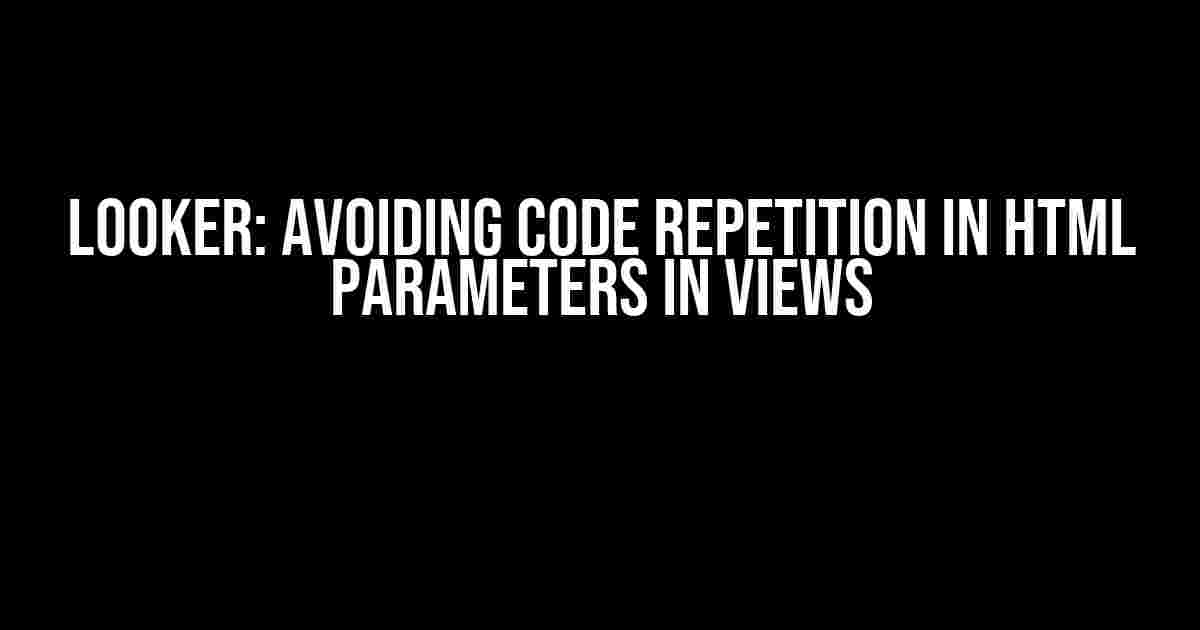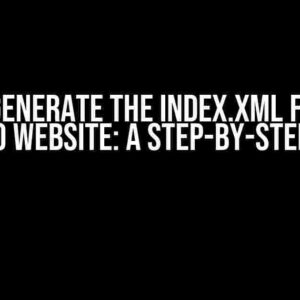As a Looker developer, you’ve likely encountered the frustration of dealing with repeated code in your HTML parameters in views. It’s a common problem that can lead to messy, hard-to-maintain code. But fear not, dear developer! In this article, we’ll explore the best practices for avoiding code repetition in Looker and show you how to write clean, efficient code that’s a pleasure to work with.
Why Code Repetition is a Problem
Before we dive into the solutions, let’s take a step back and understand why code repetition is an issue in the first place. Here are just a few reasons why you should strive to avoid repeated code:
- Readability**: Repeated code can make your views difficult to read and understand, making it harder for others (or yourself) to maintain and update.
- Maintenance**: When you need to make changes to a repeated code block, you’ll have to update it in multiple places, which can be time-consuming and prone to errors.
- Efficiency**: Writing the same code over and over can be a waste of time, especially when you’re working on large, complex projects.
Parameterizing Your HTML
So, how do you avoid code repetition in Looker? The answer lies in parameterizing your HTML using Looker’s built-in features. One of the most powerful tools at your disposal is the {{ syntax, which allows you to inject data into your HTML.
{{ my_parameter }}
This syntax tells Looker to replace the {{ my_parameter }} placeholder with the actual value of the my_parameter parameter. But how do you define this parameter in the first place?
Defining Parameters in Your Model
In your Looker model, you can define parameters using the parameter keyword. For example:
parameter: my_parameter {
type: string
}
This code defines a string parameter called my_parameter. You can then use this parameter in your views to inject dynamic data.
Using HTML Parameters in Your Views
Now that you’ve defined your parameter, it’s time to use it in your view. Let’s say you have a view that looks like this:
view: my_view {
sql_table_name: my_table ;;
dimension: my_column ;;
html: {
h1: {{ my_parameter }}
}
}
In this example, the {{ my_parameter }} placeholder is used to inject the value of the my_parameter parameter into the h1 HTML element.
Reducing Code Repetition with Macros
Macros are reusable code blocks that can help you avoid repetition in your views. In Looker, you can define a macro using the macro keyword:
macro: my_macro {
html: {
h1: {{ my_parameter }}
p: This is a reusable code block!
}
}
Once you’ve defined your macro, you can use it in multiple views to avoid repeating the same code:
view: my_view_1 {
sql_table_name: my_table_1 ;;
dimension: my_column_1 ;;
html: {{ my_macro }}
}
view: my_view_2 {
sql_table_name: my_table_2 ;;
dimension: my_column_2 ;;
html: {{ my_macro }}
}
By using macros, you can reduce code repetition and make your views more maintainable.
Using Tables to Avoid Repetition
Another way to avoid code repetition is to use tables to store reusable data. In Looker, you can create a table that stores a list of values:
view: my_table {
column: my_column {
data_type: string
values: [
"Value 1",
"Value 2",
"Value 3"
]
}
}
Once you’ve defined your table, you can use it in your views to inject dynamic data:
view: my_view {
sql_table_name: my_table ;;
dimension: my_column ;;
html: {
ul {
{{ my_table.values | each }} {
li: {{ . }}
}
}
}
}
In this example, the {{ my_table.values | each }} syntax is used to iterate over the values in the my_table table and inject them into the HTML.
Best Practices for Avoiding Code Repetition
Now that you’ve learned the techniques for avoiding code repetition in Looker, here are some best practices to keep in mind:
- Keep it DRY (Don’t Repeat Yourself)**: This is the golden rule of coding. If you find yourself writing the same code over and over, take a step back and think about how you can avoid repetition.
- Use parameters and macros**: Looker’s built-in features can help you avoid code repetition. Use parameters to inject dynamic data and macros to define reusable code blocks.
- Keep your code organized**: Break up your code into smaller, reusable components. This will make it easier to maintain and update your views.
- Test and iterate**: Don’t be afraid to experiment and try new things. Test your code and iterate on your solutions to find the best approach.
Conclusion
Avoiding code repetition in Looker is all about using the right techniques and tools to write clean, efficient code. By parameterizing your HTML, using macros, and storing reusable data in tables, you can reduce the amount of repeated code in your views and make them more maintainable. Remember to keep it DRY, use parameters and macros, keep your code organized, and test and iterate to find the best approach. With these best practices in mind, you’ll be well on your way to becoming a Looker master!
Frequently Asked Questions
Get the skinny on avoiding code repetition in HTML parameters in views with Looker – we’ve got the 411!
What’s the deal with code repetition in HTML parameters in views, and how does Looker come into play?
Code repetition in HTML parameters in views can be a real pain, making it tough to maintain and update your code. Looker comes to the rescue by providing a solution that allows you to avoid this repetition, making your code more efficient and easier to manage. With Looker, you can define a single parameter and reuse it across multiple views, reducing clutter and making your code more scalable.
How do I define a parameter in Looker to avoid code repetition?
Easy peasy! To define a parameter in Looker, you can create a new parameter in your view’s parameter list. Then, you can reference this parameter in your HTML code using the `{{ }}` syntax. For example, if you define a parameter called `header_text`, you can reference it in your HTML code like this: `{{ header_text }}`. This way, you can reuse the same parameter across multiple views, avoiding code repetition.
What’s the benefit of using a single parameter across multiple views in Looker?
The benefits are many! By using a single parameter across multiple views, you can maintain consistency across your application, reduce clutter, and make updates a breeze. If you need to change the value of the parameter, you only need to update it in one place, and it will be reflected across all views that use it. This approach also makes your code more scalable and easier to manage, as you can reuse the same parameter in different contexts.
Can I use Looker’s parameters to avoid code repetition in JavaScript code as well?
You bet! Looker’s parameters aren’t just limited to HTML code. You can also use them to avoid code repetition in your JavaScript code. By referencing a Looker parameter in your JavaScript code, you can reuse the same value across multiple views, reducing code duplication and making your code more efficient. Simply use the `looker.parameters` object to access the parameter value in your JavaScript code.
Are there any best practices I should follow when using Looker’s parameters to avoid code repetition?
Absolutely! When using Looker’s parameters to avoid code repetition, it’s essential to follow some best practices. First, make sure to define your parameters in a clear and concise manner, using descriptive names that make sense. Second, use a consistent naming convention across your application to avoid confusion. Finally, document your parameters and their usage to ensure that your team can easily understand and maintain your code.








